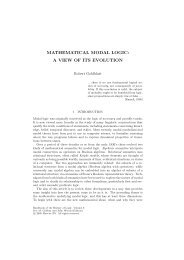Model Theory of Differential Fields
Model Theory of Differential Fields
Model Theory of Differential Fields
Create successful ePaper yourself
Turn your PDF publications into a flip-book with our unique Google optimized e-Paper software.
MODEL THEORY OF DIFFERENTIAL FIELDS 57Theorem 2.2 (Seidenberg’s <strong>Differential</strong> Nullstellensatz). Let K bea differentially closed field. I ↦→ V δ (I) is a one to one correspondence betweenradical δ-ideals and δ-closed sets.Pro<strong>of</strong>. It is easy to see that I δ (Y ) is a radical δ-ideal for all Y ⊆ K n . SupposeI and J are radical δ-ideals and g ∈ J \ I. By Theorem 2.1 there is a primeδ-ideal P ⊇ I with g ∉ P . It suffices to show there is x ∈ V δ (P ) with g(x) ≠ 0.Let P = √ 〈f 1 , . . . , f m 〉, and let L be a differentially closed field containingK{X 1 , . . . , X n }/P . Let x = (X 1 /P, . . . , X n /P ). Clearly f(x) = 0 for f ∈ P andg(x) ≠ 0. In particular,L |= ∃v 1 . . . ∃v n f 1 (v 1 , . . . , v n ) = . . . = f m (v 1 , . . . , v n ) = 0 ∧ g(v 1 , . . . , v n ) ≠ 0.By model completeness the same sentence is true in K. Thus there is x ∈ K nsuch that x ∈ V δ (P ) \ V δ (J).□By the basis theorem every δ-closed set is definable. We say that a subset <strong>of</strong> K nis δ-constructible if it is a finite boolean combination <strong>of</strong> δ-closed sets. The δ-constructible sets are exactly those defined by quantifier free L-formulas. Quantifierelimination implies that the δ-constructible sets are exactly the definablesets. Thus the projection <strong>of</strong> a δ-constructible set is δ-constructible.3. ω-Stability and DimensionLet K be a differentially closed fields and let F be a differential subfield <strong>of</strong> K.If p ∈ S n (F ), let I δ (p) = {f ∈ F {X 1 , . . . , X n } : “f(x 1 , . . . , x n ) = 0” ∈ p}. Thearguments for types in algebraically closed fields in [Marker 2000] work here toshow that p ↦→ I p is a bijection from S n (F ) onto the space <strong>of</strong> prime δ-ideals.Corollary 3.1. DCF is ω-stable.Pro<strong>of</strong>. Let K and F be as above. We must show that |S n (F )| = |F |. But forall p, we can find f 1 , . . . , f m such that I δ (p) = √ 〈f 1 , . . . , f m 〉. Thus the number<strong>of</strong> complete n-types is equal to |F {X 1 , . . . , X n }| = |F |.□There is an important algebraic application <strong>of</strong> ω-stability. If F is a differentialfield, we say that a differentially closed K ⊇ F is a differential closure <strong>of</strong> F iffor any differentially closed L ⊇ F there is a differential embedding <strong>of</strong> K into Lfixing F .This is related to a general model-theoretic notion mentioned in [Hart 2000].A prime model <strong>of</strong> T over A is a model M |= T with A ⊆ M, such that if N |= Tand A ⊂ N, then there is an elementary embedding j : M → N such that j|A isthe identity. For DCF, prime model extensions are exactly differential closures(recall that, by model completeness, all embeddings are elementary).Theorem 3.2. Let T be an ω-stable theory, M |= T and A ⊆ M. There is aprime model <strong>of</strong> T over A. If N 0 and N 1 are prime models <strong>of</strong> T over A, then N 0and N 1 are isomorphic over A.
















